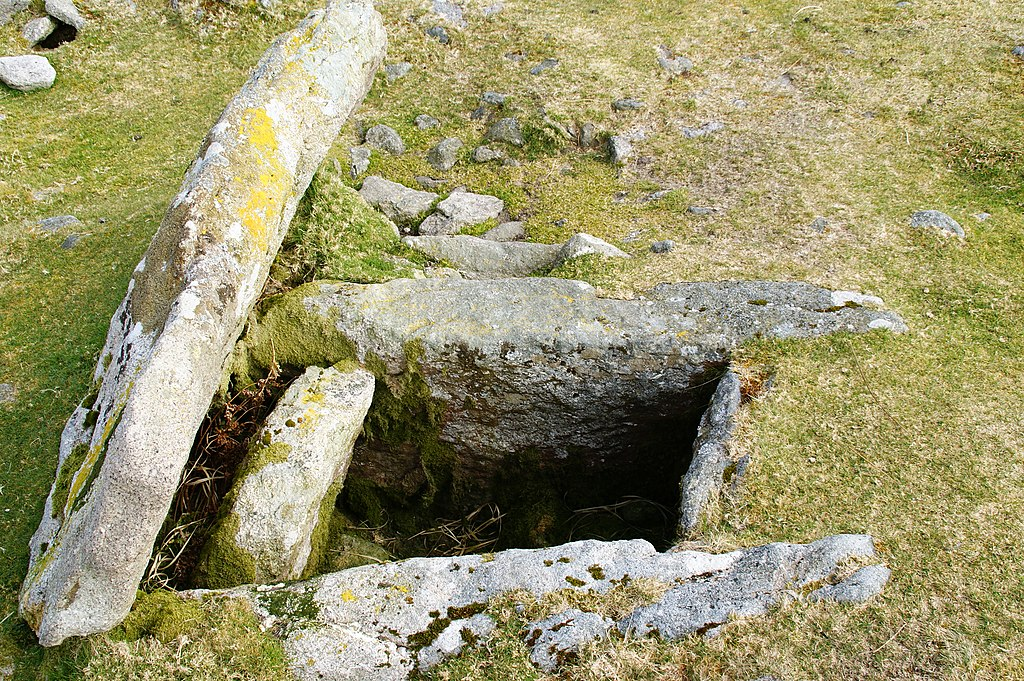
Kist or Cist and Kistivan

A kistvaen or cistvaen is a tomb or burial chamber formed from flat stone slabs in a box-like shape. If set completely underground, it may be covered by a tumulus. The word is derived from the Welsh cist (chest) and maen (stone). The term originated in relation to Celtic structures, typically pre-Christian, but in antiquarian scholarship of the 19th and early 20th centuries it was sometimes applied to similar structures outside the Celtic world.
- Cyril M. Harris, Illustrated Dictionary of Historic Architecture (Courier Dover Publications, 1983), p. 118 with illustration online.
One of the most numerous kinds of kistvaen are the Dartmoor kistvaens. These often take the form of small rectangular pits about 3 ft. (0.9 m) long by 2 feet (0.6 m) wide. The kistvaens were usually covered with a mound of earth and surrounded by a circle of small stones. When a body was placed in the kistvaen, it was usually lain in a contracted position. Sometimes however the body was cremated with the ashes placed in a cinerary urn.
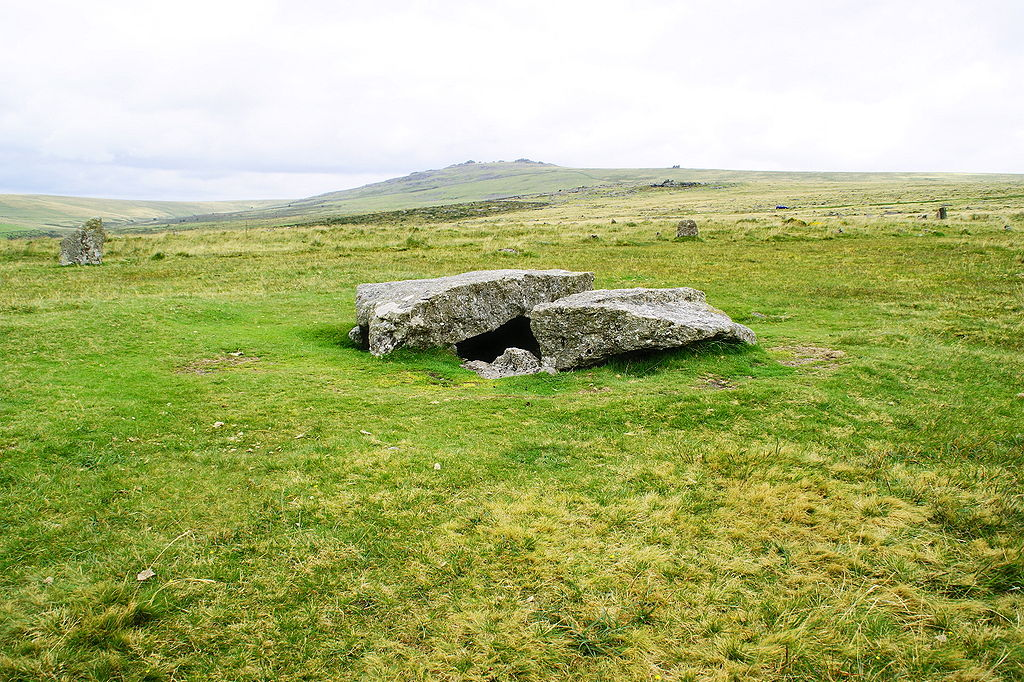
A cist from Greek: κίστη, Middle Welsh Kist or Germanic Kiste) is a small stone-built coffin-like box or ossuary used to hold the bodies of the dead. Examples can be found across Europe and in the Middle East. A cist may have been associated with other monuments, perhaps under a cairn or long barrow. Several cists are sometimes found close together within the same cairn or barrow. Often ornaments have been found within an excavated cist, indicating the wealth or prominence of the interred individual.
- Houghton Mifflin (2000). The American Heritage Dictionary of the English Language (4th ed.). Boston and New York: Houghton Mifflin. pp. 339. ISBN 978-0-395-82517-4.
- Merriam-Webster Unabridged (MWU). (Online subscription-based reference service of Merriam-Webster, based on Webster’s Third New International Dictionary, Unabridged. Merriam-Webster, 2002.) Headword cist. Accessed 2007-12-11.
- “A Cist Burial in Jordan”.
- Callaway, Joseph A. (1963). “Burials in Ancient Palestine: From the Stone Age to Abraham”. The Biblical Archaeologist. 26 (3): 74–91. doi:10.2307/3210997. JSTOR 3210997. S2CID 165441707.
- “The Early Minoan Period: The Tombs”. Archived from the original on 2008-03-23. Retrieved 2008-03-30.
- “Excavation of Cist in Bologna, Italy”.
This old word is preserved in the Nordic languages as “kista” in Swedish and “kiste” in Danish and Norwegian, where it is the word for a funerary coffin. In English it is related to “cistern”.


Keywords: Religion; Prehistory; Magic; Archaeology
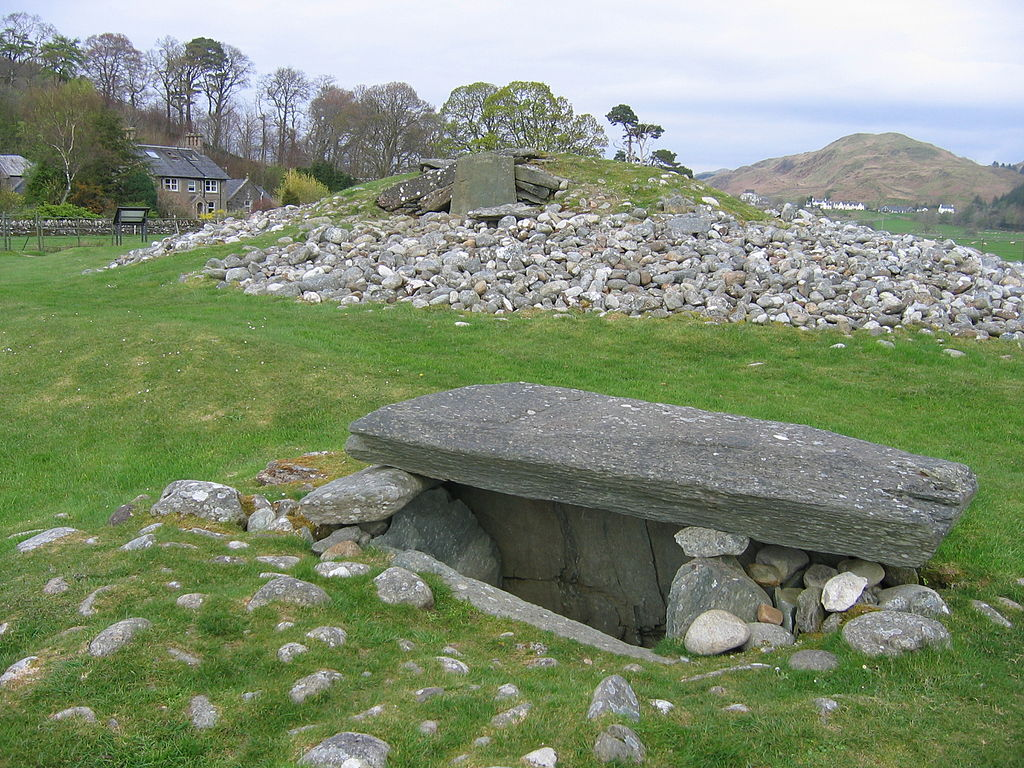
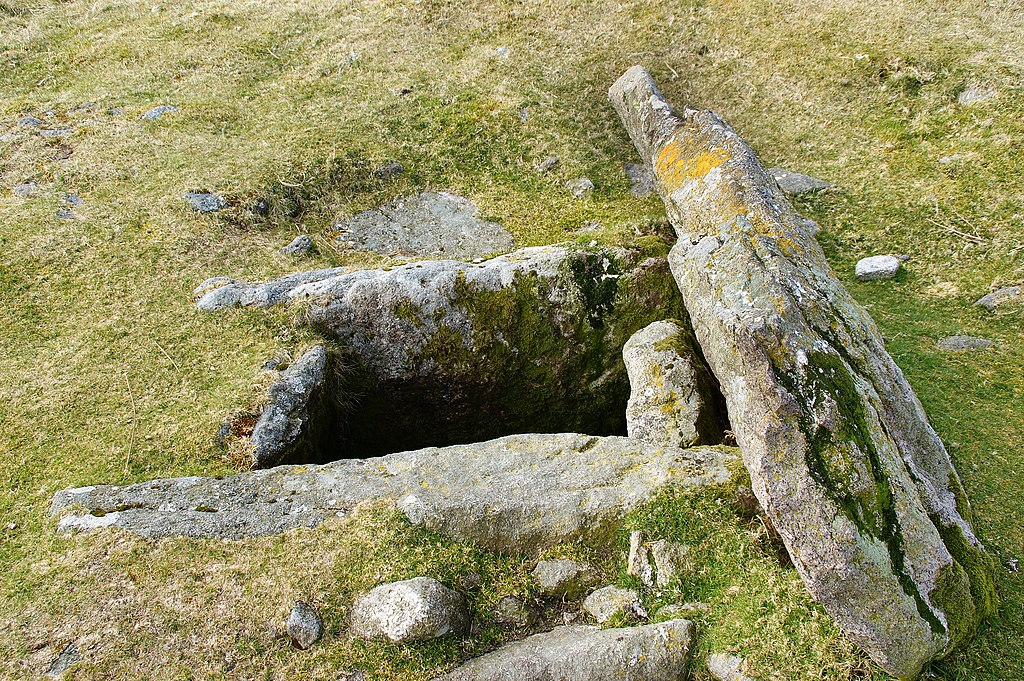
Kistvaens and Celtic saints
Kistvaens are also found associated with holy sites or burial places of early Celtic saints, who are often semi-legendary. Saints associated with kistvaens include Callwen daughter of Brychan, Geraint, Begnet, and Melangell. Foundation remains of stone slab- or gable-shrines, or the cella memoriae of Mediterranean origin, may sometimes have been misunderstood in an earlier era of scholarship as a kistvaen, and the subject is complicated by this “woolly nomenclature.”
- Baring-Gould and John Fisher, The Lives of the British Saints (London, 1908) p. 67 online and vol. 3, p. 51 online
- In the quoted passage incorrectly identified as St. Benedict; Joseph P. O’Reilly, “Notes on the Orientations and Certain Architectural Details of the Old Churches of Dalkey Town and Dalkey Island,” Proceedings of the Royal Irish Academy 24 (1903), p. 196 online.
- Nancy Edwards, “Celtic Saints and Early Medieval Archaeology,” in Local saints and local churches in the early medieval West (Oxford University Press, 2002), pp. 234ff., with photo. Scholars may describe the kind of structure called a “kistvaen” rather than using the term itself.
- Ulster Journal of Archaeology 63 (2004), p. 144.
- A cella memoriae (from Latin , “room of “memory (place)” or “remembrance room”), in architecture , is a small building , a chapel erected over one or more tombs by the early Christians of the West as a dedication to the memory of the deceased buried there and the celebration of their anniversaries. These buildings, like temples , were also used by pagans for the same purpose. However, in the case of Christian martyrs , these chapels, either above or below ground, are usually called martyria (singular, martyrium , “testimony”) or confessions. They were indicative that there were relics that enjoyed special veneration. Initially, the isolated chapel was built outdoors, on top of the Christian catacombs , with a square plan, usually with one, three or four apses . The most common was with one or three apses, then called a trefoil plan. In the era of tolerance of Christianity, these chapels were used to receive commemorative and votive offerings and celebrate worship ceremonies. However, with the Edict of Milan (313), after the freedom of worship of religions, including Christianity, this type of construction no longer has a reason to exist, giving way to the reuse of the ancient Roman basilicas , larger, and the construction of new basilicas that are prepared to carry out all kinds of Christian worship there. They can only be reconstructed archaeologically, since they were abandoned in early times and fell into disrepair or served as the base of large buildings and churches, being found under their foundations, mainly in the middle of the crypt and where the main altar is located . These cellas are considered the architectural antecedent of the chancel . The generic Christian basilica can be said to be the result of the fusion of two pre-Constantinian constructions: on the one hand, the titulus or patrician house as the body of the building and meeting place, and the cella memoriae for the head. Autotranslated from https://es.wikipedia.org/wiki/Cella_memoriae
Regional examples
- Bellanbedipalassa[citation needed]
- Pothana[citation needed]
- Ibbankatuwa Megalithic Stones
- Udaranchamadama
England
- Bellever Forest, Dartmoor
- Hepburn woods, Northumberland[citation needed]
Estonia
- Jõelähtme (Rebala) stone-cist graves, Harju County
Latvia
- Batariņi
- Grīviņš, Valters (2017). “Vidzemes arheoloģiskās apbedījumu vietas” (PDF). Historia.lv.
Guatemala
- Mundo Perdido, Tikal, Petén Department
Israel
- Tel Kabri (Area A), Upper Galilee
Scotland
- Balblair cist, Beauly, Inverness[citation needed]
- Dunan Aula, Craignish, Argyll and Bute
- Holm Mains Farm, Inverness
- Nether Mill, Kilbirnie, North Ayrshire
See also
- Kistvaen
- Dartmoor kistvaens
- Stone box grave
- Dolmen, a type of above-ground burial chamber
References
- Houghton Mifflin (2000). The American Heritage Dictionary of the English Language (4th ed.). Boston and New York: Houghton Mifflin. pp. 339. ISBN 978-0-395-82517-4.
- Merriam-Webster Unabridged (MWU). (Online subscription-based reference service of Merriam-Webster, based on Webster’s Third New International Dictionary, Unabridged. Merriam-Webster, 2002.) Headword cist. Accessed 2007-12-11.
- “A Cist Burial in Jordan”.
- Callaway, Joseph A. (1963). “Burials in Ancient Palestine: From the Stone Age to Abraham”. The Biblical Archaeologist. 26 (3): 74–91. doi:10.2307/3210997. JSTOR 3210997. S2CID 165441707.
- “The Early Minoan Period: The Tombs”. Archived from the original on 2008-03-23. Retrieved 2008-03-30.
- “Excavation of Cist in Bologna, Italy”.
- sv:likkista
- da:ligkiste
- no:kiste
- cistern
- Grīviņš, Valters (2017). “Vidzemes arheoloģiskās apbedījumu vietas” (PDF). Historia.lv.
- Baring-Gould and John Fisher, The Lives of the British Saints (London, 1908) p. 67 online and vol. 3, p. 51 online
- In the quoted passage incorrectly identified as St. Benedict; Joseph P. O’Reilly, “Notes on the Orientations and Certain Architectural Details of the Old Churches of Dalkey Town and Dalkey Island,” Proceedings of the Royal Irish Academy 24 (1903), p. 196 online.
- Nancy Edwards, “Celtic Saints and Early Medieval Archaeology,” in Local saints and local churches in the early medieval West (Oxford University Press, 2002), pp. 234ff., with photo. Scholars may describe the kind of structure called a “kistvaen” rather than using the term itself.
- Ulster Journal of Archaeology 63 (2004), p. 144.
- Cyril M. Harris, Illustrated Dictionary of Historic Architecture (Courier Dover Publications, 1983), p. 118 with illustration online.
External links
Wikimedia Commons has media related to Cist graves.
Look up kistvaen in Wiktionary, the free dictionary.
Wikimedia Commons has media related to Kistvaen.
- Dartmoor tomb raiders
- Dartmoor Kistvaen
- Pretanic World – Chart of Neolithic, Bronze Age and Celtic Stone Structures
| Neolithic Europe (including the Chalcolithic) |
|---|


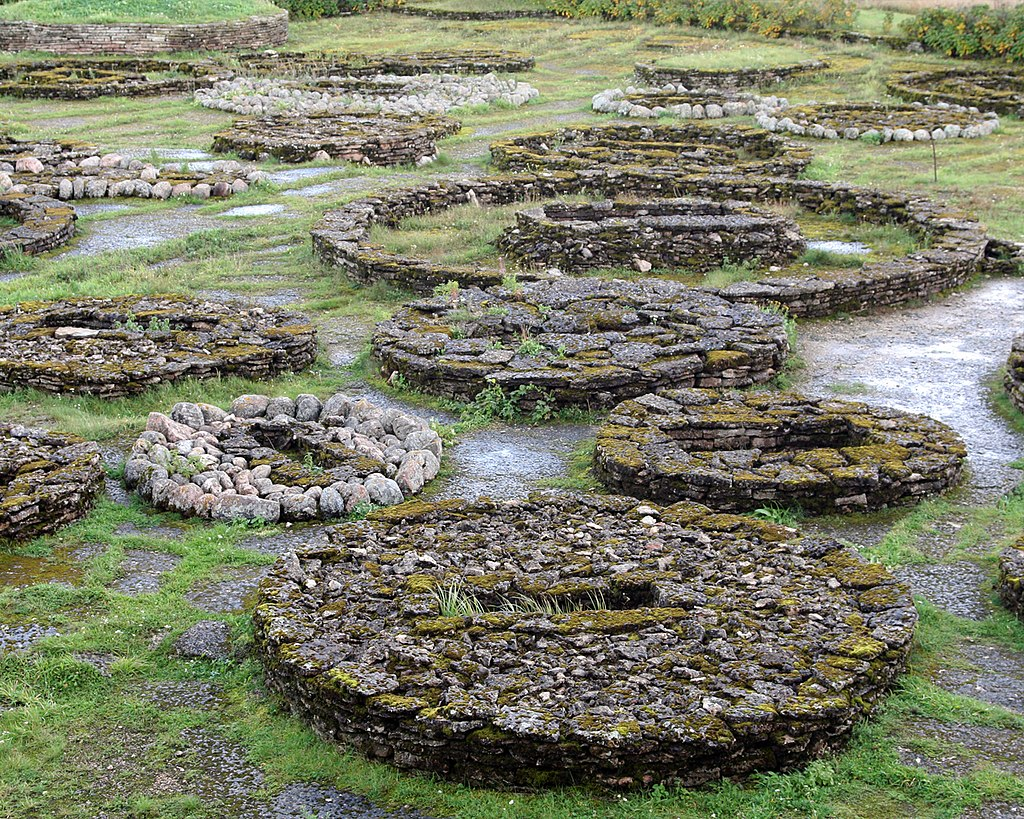
Leave a Reply